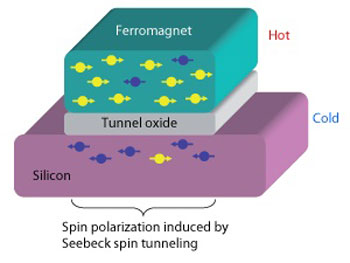| Sep 20, 2011 |
Demonstration of Seebeck Spin Tunneling could lead to efficient spin current generation
|
|
(Nanowerk News) Spintronics has the potential to provide many advantages over traditional charge-based electronics. Crucial to the practical viability of the technology, however, is the efficient generation and control of 'spin currents' — flows of electron spins with high polarization purity. One technique that is widely used experimentally to generate a spin current is the application of a voltage across a magnetic tunneling junction (MTJ). This configuration injects electrons from a ferromagnetic electrode into, for instance, a non-magnetic material via a tunneling barrier, which acts as a spin filter.
|
|
Ron Jansen and colleagues from the Spintronics Research Center at the National Institute of Advanced Industrial Science and Technology in Japan with co-workers in the Netherlands have now demonstrated the possibility of injecting a spin current into silicon by applying a temperature gradient across a MTJ to induce Seebeck spin tunneling ("Thermal spin current from a ferromagnet to silicon by Seebeck spin tunnelling").
|
 |
| Schematic illustration of the Seebeck spin tunneling effect in a magnetic tunneling junction. (© 2011 NPG)
|
|
Seebeck spin tunneling is a purely interface-related phenomenon that is directly related to the spin-dependent Seebeck coefficient of an MTJ. The basic idea is that a difference in temperature across the barrier of an MTJ induces a flow of electrons with energy above the 'Fermi' level from the hot side to the cold side, along with a corresponding flow of electrons below the Fermi level in the opposite direction. The two currents cancel each other, but if the spin orientations of the cancelling charges are polarized differently, spin can accumulate on the nonmagnetic side, in this case the silicon, despite the zero charge current.
|
|
The team confirmed this spin accumulation by measuring the voltage in zero current conditions. They observed a component of this voltage that depends on the applied magnetic field, from which they could extract the amount of spin accumulated.
|
|
Aside from its fundamental interest, Seebeck spin tunneling could also prove useful in devices. "Seebeck spin tunneling provides an alternative way to create a spin current that could replace the conventional electrical method, or assist it. Applications may thus be found in devices that rely on spin currents, such as spin transistors, spin logic or opto-spintronic devices," says Jansen. Particularly promising is the potential to utilize the heat generated by circuit components to drive the circuits themselves.
|

